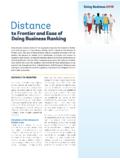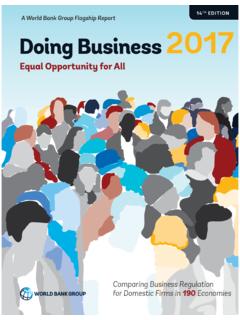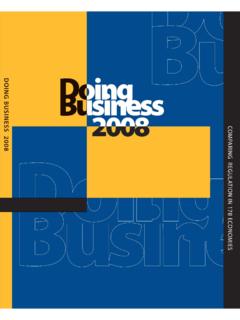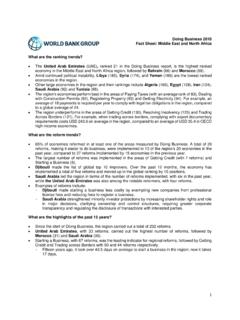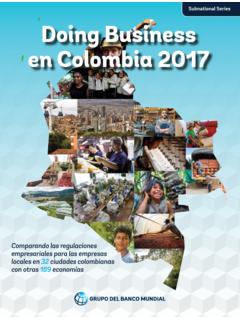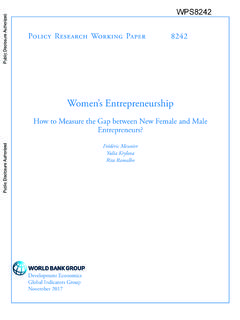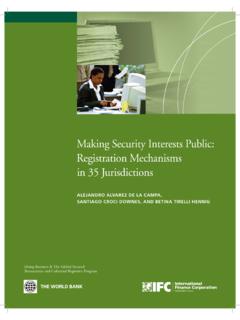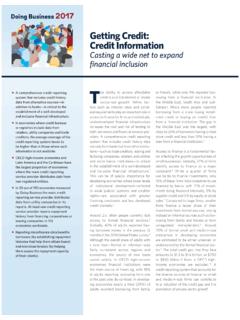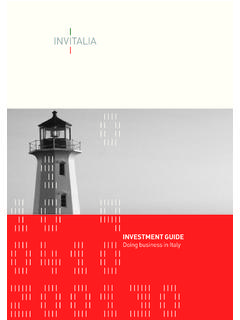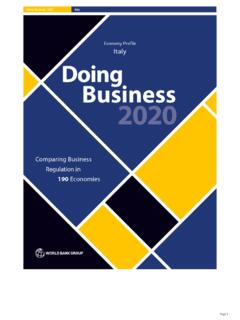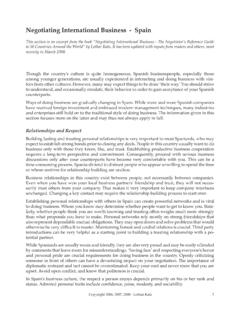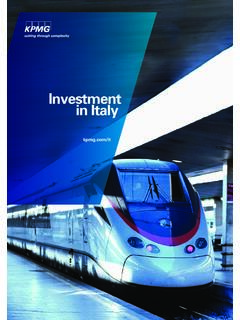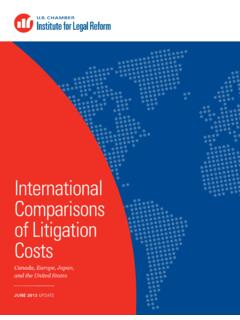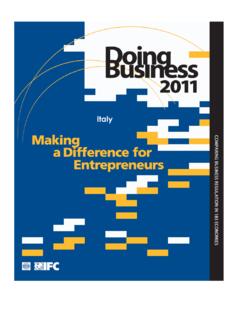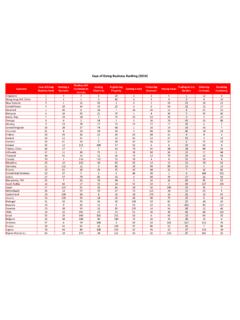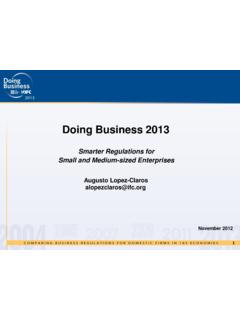Transcription of DOING BUSINESS IN ITALY 2013
1 COMPARING BUSINESS REGULATIONS FOR DOMESTIC FIRMS IN 13 CITIES AND 7 PORTS WITH 185 ECONOMIESDOING BUSINESS Smarter Regulations for Small and Medium-Size EnterprisesIN ITALY 2013 SUBNATIONAL 2013 International Bank for Reconstruction and Development / The World Bank1818 H Street NWWashington, DC 20433 Telephone: 202-473-1000 Internet: rights reserved. 1 2 3 4 15 14 13 12A copublication of The World Bank and the International Finance work is a product of the staff of The World Bank with external contributions. Note that The World Bank does not necessarily own each component of the content included in the work. The World Bank therefore does not warrant that the use of the content contained in the work will not infringe on the rights of third parties.
2 The risk of claims resulting from such infringement rests solely with findings, interpretations, and conclusions expressed in this work do not necessarily reflect the views of The World Bank, its Board of Executive Directors, or the governments they represent. The World Bank does not guarantee the accuracy of the data included in this work. The boundaries, colors, denominations, and other information shown on any map in this work do not imply any judgment on the part of The World Bank concerning the legal status of any territory or the endorsement or acceptance of such herein shall constitute or be considered to be a limitation upon or waiver of the privileges and immunities of The World Bank, all of which are specifically and PermissionsThis work is available under the Creative Commons Attribution Unported license (CC BY ) Under the Creative Commons Attribution license, you are free to copy, distribute, transmit, and adapt this work, including for commercial purposes, under the following conditions:Attribution Please cite the work as follows: World Bank.
3 2013. DOING BUSINESS in ITALY 2013: Smarter Regulations for Small and Medium-Size Enterprises. Washington, DC: World Bank Group. License: Creative Commons Attribution CC BY If you create a translation of this work, please add the following disclaimer along with the attribution: This translation was not created by The World Bank and should not be considered an official World Bank translation. The World Bank shall not be liable for any content or error in this queries on rights and licenses should be addressed to the Office of the Publisher, The World Bank, 1818 H Street NW, Washington, DC 20433, USA; fax: 202-522-2625; e-mail: and Layout: Corporate Visions, COPUBLICATION OF THE WORLD BANK AND THE INTERNATIONAL FINANCE CORPORATIONCOMPARING BUSINESS REGULATIONS FOR DOMESTIC FIRMS IN 13 CITIES AND 7 PORTS WITH 185 ECONOMIESITALYS marter Regulations for Small and Medium-Size EnterprisesSUBNATIONAL DOING BUSINESS IN ITALY 2013iiTHE DOING BUSINESS WEBSITED oing BUSINESS in ITALY 2013 featuresNews on the DOING BUSINESS project BUSINESS reforms Short reform summaries and researchThe methodology and research papers underlying DOING BUSINESS reportsAccess to DOING BUSINESS reports as well as subnational and regional reports.
4 Reform case studies and customized economy and regional profiles and regional projectsDifferences in BUSINESS regulations at the subnational and regional level libraryOnline collection of laws and regulations relating to BUSINESS and gender issues PlanetInteractive map on the ease of DOING summary 1 About DOING BUSINESS and DOING BUSINESS in ITALY 2013 8 Starting a BUSINESS 19 Dealing with construction permits 26 Registering property 32 Enforcing contracts 36 Trading across borders 42 Data notes 48 City tables 58 Indicator tables 61 List of procedures: starting a BUSINESS 64 List of procedures: dealing with construction permits 71 List of procedures: registering property 91 Indicator details enforcing contracts 98 Indicator details trading across borders 99 Acknowledgments 100 DOING BUSINESS in ITALY 2013 is a new subna-tional report of the DOING BUSINESS series.
5 It measures BUSINESS regulations and their en-forcement across 4 indicators in 13 Italian cit-ies: Bari (Apulia), Bologna (Emilia-Romagna), Cagliari (Sardinia), Campobasso (Molise), Catanzaro (Calabria), L Aquila (Abruzzo), Milan (Lombardy), Naples (Campania), Padua (Veneto), Palermo (Sicily), Potenza (Basilicata), Rome (Latium), and Turin (Piedmont) and the indicator trading across borders in 7 ports: Cagliari (Sardinia), Catania (Sicily), Genoa (Liguria), Gioia Tauro (Calabria), Naples (Campania), Taranto (Apulia), Trieste (Friuli-Venezia Giulia). The cities were selected by the Department for Planning and Coordination of Economic Policy (DIPE) of the Presidency of the Council of Ministers of the Italian Republic.
6 The cities can be compared against each other, and with 185 economies worldwide. Comparisons with other economies are based on the indicators in DOING BUSINESS 2013: Smarter Regulations for Small and Medium-Size Enterprises, the tenth in a series of annual reports published by the World Bank and the International Finance Corporation. The indicators in DOING BUSINESS in ITALY 2013 are also comparable with over 350 cities from more than 50 economies benchmarked in other subnational DOING BUSINESS stud-ies. All data and reports are available at BUSINESS investigates the regulations that enhance BUSINESS activity and those that constrain it. Regulations affecting 5 stages of the life of a BUSINESS are measured at the subnational level in ITALY : starting a BUSINESS , dealing with construction permits, registering property, trading across borders and enforc-ing contracts.
7 These indicators were selected because they cover areas of local jurisdiction or practice. The indicators are used to ana-lyze economic outcomes and identify what reforms have worked, where and why. The data in DOING BUSINESS in ITALY 2013 are current as of June 1st, 2012. This project is the result of collaboration of the Government of the Italian Republic s Department for Planning and Coordination of Economic Policy of the Presidency of the Council of Ministers (DIPE) with the Global Indicators and Analysis Department of the World Bank Group. 1 Executive summary In the 1950s and 60s, ITALY successfully made the transition from a rural economy with a large agricultural sector, to one where industry and manufacturing are the engines of However, over the past two decades, ITALY s growth rate lagged behind other EU countries, such as Germany and France.
8 The current global crisis originated abroad, but longstanding structural weaknesses have exacerbated its effects inside ITALY and triggered the worst recession in decades. Since 2008, ITALY s economy has shrunk by more than 5%. Today, unemployment is at and youth unemployment has hit a record And despite the government s prudent fiscal policy, ITALY s public debt-to-GDP ratio is among the highest of the OECD high-income economies, while its private debt levels remain relatively The International Monetary Fund (IMF) expects the Italian economy to contract by another in 2012 and by in 2013 with growth returning, albeit only moderately, in s ranking on the World Economic Forum (WEF) s competitiveness index is 21st out of the 27 EU member ITALY s main strengths are well-developed enterprise clusters, a broad presence in the value chain, corporate activity spread among many firms and high firm-level innovation.
9 However, the WEF report recognizes that ITALY s potential is not fully realized due to weak competition, burdensome government regulations and red-tape. Without reforms to address these structural gaps and obstacles to competitiveness, ITALY s growth is likely to remain sluggish over the medium 2011, ITALY s government has taken far-reaching measures to restore confi-dence, stabilize the fiscal situation and remedy structural weaknesses. Under the auspices of the Europe 2020 Strategy for Intelligent, Sustainable and Inclusive Growth, ITALY s Stability Program and National Reform Program focus on fis-cal consolidation, on the one hand, and promoting growth, on the The fiscal consolidation measures include adjusting taxation to increase taxes on consumption and property while reduc-ing taxes on BUSINESS activity and work.
10 The debt reduction strategy is to rein in spending in the medium term. However, the heart of ITALY s problem was and is how to get back to more buoyant economic growth. At a time of crisis, this growth cannot come from an unsustain-able expansion of public spending and there is also recognition of the limits of prolonged austerity. There is, in fact, greater acceptance among policymakers and the BUSINESS community that growth has to come from boosting total-factor productivity. This means increasing efficiency, productivity and competitive-ness by allowing more competition in the product and services markets, encourag-ing small and medium-size firms to invest more on innovation, further liberalizing the economy, reforming the labor market and creating a flexible and simple fiscal system that is transparent and efficient in its administration.
